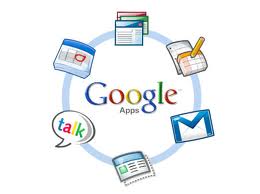ePortfolio with Google Apps Series: Introduction

Glossary: Primary Responsibility for ePortfolio Component
All School (AS)
Teacher (T)
Student (S)
Advisor (A)
Steps for using GoogleApps throughout the Portfolio Development Process
- (AS) Purpose. Decide on the purpose for the portfolio.
What are you trying to show with this portfolio? Are there outcomes,
goals, or standards that are being demonstrated with this portfolio? In
this example, steps 2-4 represent an interative process, using a blog to provide formative
feedback on student work on a regular basis.
- Teachers, Admin and (eventually) Students: Set up templates for student work in GoogleDocs organized around outcomes, goals and standards?
- Students: Customize a Google Sites page that will serve as the opening
page/Introduction to the portfolio and to the portfolio developer (see
Section 6 below). This page will include a section entitled, "All
About Me."
- Students create a Google Sites Announcements
page type, to use as a reflective journal (blog). Call the page
"Journal" or "Blog." Create a first post that describes the purpose for
developing this portfolio.
OR: Students create a blog in Blogger (included under the GoogleApps domain)
(S) Collection/Classification. What artifacts will you include in your portfolio? How will you classify these entries?
-
Students: Create a digital archive of work Using GoogleDocs. Offline, this archive would
be
on a hard drive, flash drive, iPod or local area network server.
- Students: (Optional) Use a
simple table or GoogleDocs Spreadsheet to list the artifacts, and assign (classify)
each one to the outcome/goal/standard that the artifact will
demonstrate. Use the table to keep track of artifacts that might be
stored on one of the many Web 2.0 sites that you could use to store
your work. See Dr. Barrett’s portfolio for an example (Artifacts in GoogleDocs Spreadsheet).
Students will: convert all attached artifacts into web-compatible formats
(JPEG or PDF) so that the potential reader will not need to own the
original software in order to read it (i.e., Microsoft Office,
Publisher, Inspiration documents could easily be converted into PDF and
attached to a blog entry, or link to GoogleDocs).
Web 2.0 storage: Video files can
be saved on one of the video sharing sites, and use the Hyperlink or
Embed code to include in your blog entry. Word, Excel and PowerPoint
files could be uploaded into GoogleDocs. Other
free websites that allow you to store documents: SlideShare, Scribd. Most of these Web 2.0 sites use an email address as the log-in name, so it will be easy to remember.
(S, T, A)Reflection. Reflection is the heart and soul of a
portfolio.
Reflection provides the rationale for why these artifacts
represent achievement of a particular outcome, goal or standard. Blog
entries provide an opportunity for reflection "in the present tense" or
"reflection in action."
- Teachers: Provide students with resources to support their reflection
activities. For each learning activity or artifact, what should be the
focus of the students' reflections? (See Dr. Barrett's Google Site on Reflection for Learning)
- Students:
Write a blog entry (using Journal set up using GoogleSites
Announcements page type, or in Blogger--Step #1 above) with a reflection
on each learning activity or artifact (what is the context in
which this artifact was developed? What did you learn?).
- Students: Add your own classification using Tags
- Students: Add appropriate artifacts (through hyperlinks) or as an attachment to the journal entry.
Privacy Features:
Students can limit who can read the Google Site through the More Actions ->Share this Site menu item.
(AS) Connection/Interaction/Dialogue/Feedback. This stage
provides an opportunity for interaction and feedback on the work posted
in the portfolio. This is where the power of Web 2.0 interactive tools
becomes apparent.
- Teachers and Peers: Use the feedback features of Google Sites or GoogleDocs,
such as comments, to provide feedback on the work posted in the
ePortfolio/blog entries. Guidelines should be provided to support more effective feedback.
- Teachers often provide exemplars for different levels of achievement, and provide a rubric for evaluation.
- Students should be given the option of updating the work, based on the feedback and the rubric.
REPEAT steps 3-4 for each learning activity or artifact.
Summative Reflection/Selection/Evaluation. At the end of a course (or program), students
would write a reflection that looks back over the course (or program)
and provides a meta-analysis of the learning experience as represented
in the reflections stored in the blog/journal entries.
- Students: Review the blog/journal entries for that category,
and write a last "retrospective reflection" about the learning
represented in the artifacts, selecting one or two examples that best
represent achievement. This self-assessment should be the first part of a page set up in Google Sites.
- Students: Prepare a GoogleSites Page for each Outcome, Goal or Standard, and link to the
selected "best" blog entries, writing a reflection on each page (by
outcome/goal/standard) which should also have the artifact attached or linked.
- Teacher/Advisor: Provide feedback and/or evaluation of the selection of work and rationale, using a WHS rubric.
Presentation/Publishing. The portfolio developer decides what parts of the portfolio are to be made public.
- Student:
Create a set of pages that highlight the best components of the
portfolio, linking to specific entries in the blog. Add the evidence
(through hyperlinks to blog entries or artifacts) to the appropriate
sub-pages in the portfolio.
- Students: Customize your Introduction
page, which should contain an overview of the portfolio.
It serves as a “letter to the reader” and provides an explanation of
the overall goals of the portfolio. Provide links to other pages
developed in the portfolio. Advertise this Introduction page as the
initial access point in your portfolio.
- Students: Create a page with Future Learning Goals (reflection in the future tense).
- Teacher:
When used for summative assessment, submit final evaluation of
portfolio (assessed using a quantitative analytic rubric or a holistic
rubric).
Adapted under Free and Cultural Works with attribution to: Dr. Helen Barrett

No comments:
Post a Comment